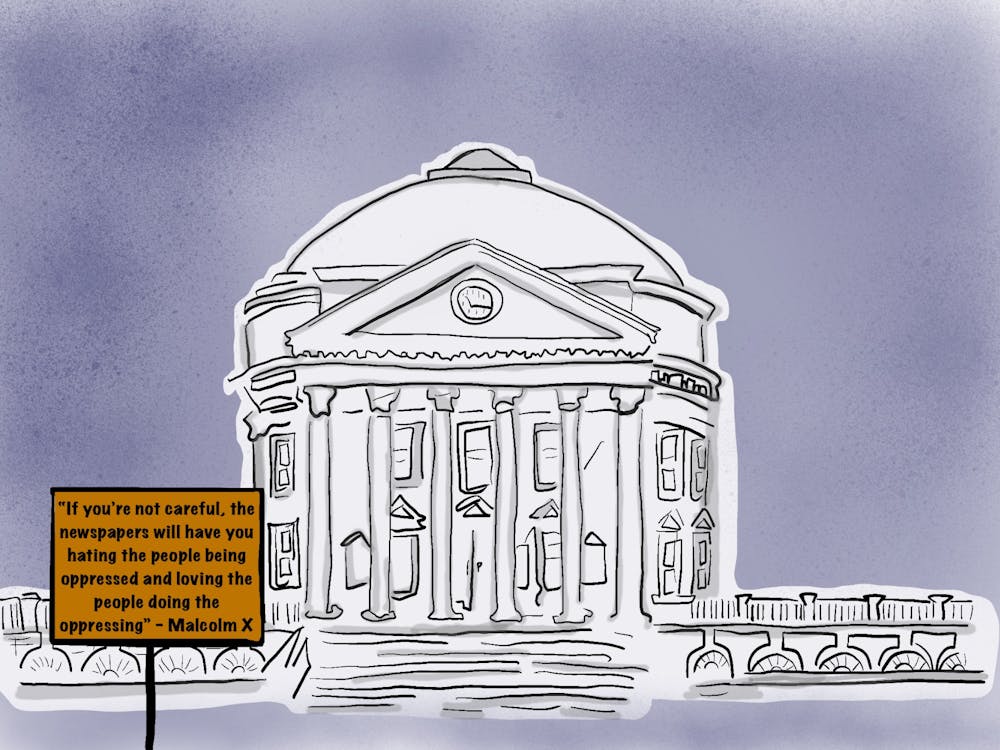Last Monday hateful graffiti was discovered on the sign in front of Elson Student Health Center which read, “UVA Hates Blacks.” Of course, the act of publicly saying something hateful, ignorant or defamatory is unacceptable. But this graffiti can be read two ways, and I think each interpretation has the ability to prompt important reflection on the University’s relationship with race and the practical implications of that relationship for minority students.
Some interpreted the message as one motivated by racism, i.e. “U.Va. and its students do not like black people; black people are not welcome here.” If that was the intended message, what does that mean for our University? Many may try to understate the significance of the graffiti or label it a freak occurrence perpetrated by one hateful and misguided person; perhaps a person who is not even a student of the University. But to largely ignore the act is irresponsible. I had only two Facebook friends post the link to the local news story. Neither of The Cavalier Daily’s tweets about it got any favorites or retweets. The subsequent news story on the website received only two likes and only three people commented. The lack of discussion or concern surrounding the incident was disappointing. The University issued a response statement, but the student body at large did not receive an email or any other notification of the event or the response. It is said there will be a police investigation of the vandalization but I doubt we will receive updates on the progress of the investigation.
According to Dean of Students Allen Groves, the University’s main objective was to keep the vandalism out of the limelight. He told The Cavalier Daily, “You don’t want to give more air time to something that’s ugly than it should deserve.” But don’t the ugly, disturbing or offensive events that occur on our Grounds deserve extra attention, not less? Acknowledging our shortcomings and talking about how to improve is the only way we can grow as a University and as people.
Our response to the incident should be about more than condemning it. And importantly, we should realize that the significance of the incident can not be gauged by white students’ reactions. I would go so far as to argue that the voices of the majority — specifically white students — are nearly irrelevant in the context of this vandalism. Sure, it may make white students feel bad or uncomfortable that their school has been associated with racial tension, but they are not the demographic which deserves our attention and our compassion in this situation.
When a local news outlet interviewed Ebonie Williams, a black woman who is a fourth year at the University, about the graffiti, she said that she was “disappointed, but not surprised” that it had happened. When the default attitude of a person is to expect racist acts to be a part of their University experience and, more largely, of their lives, there is a problem. Williams also pointed out that often, when University groups attempt to spur conversations about race, the people who most need to hear the discussions are the ones least likely to attend. So we should make the talks mandatory. We could make “racial awareness” a topic of discussion during first year orientation, at dorm meetings during the first weeks of every school year, as a prerequisite to rushing, being the officer of an extracurricular group, being an RA or OL or working in the admissions office. We need to integrate approaches to healthier race relations into our University experience, whether that means holding workshops about being sensitive to charged language and differences in background and culture, teaching people to be mindful of their words and actions, facilitating honest discussions in open forums between racially different subgroups of your organizations, or promoting pride in diversity through special events.
As a final point I want to consider the possibility that the act of vandalism was carried out by someone of a minority race. If you read the graffiti from that perspective, “UVA hates blacks” becomes, “U.Va. does not treat black people the way that it should.” And that interpretation should also cause us pause, perhaps even more urgently than the first. Again, only one person wrote the message. But if one person was feeling marginalized enough and sufficiently motivated by resentment to send a message to the entire city, then it is not a stretch to assume that other people are feeling similarly.
I am not accusing particular people — be it administrators, faculty, staff or students — of being racist. Of course the majority of our University population is not bigoted and would not think to openly express hatred toward any group. But that does not mean that there is not segregation, self-imposed or otherwise. That does not mean that some institutionalized practices of the University are not racist by nature. It does not mean that our appreciation of or respect for racial differences is sufficient.
Without being sensationalist, I would argue that the racist graffiti outside of Elson Student Health Center is indicative of a larger problem with assumptions and prejudices about race at the University, and it should have been given much more attention from both the local media and the University administrators than it was. Both administrators and student leaders have the responsibility of leading the effort to combat racial tension on Grounds, and that effort should begin as soon as possible.
Ashley Spinks is an Opinion columnist for The Cavalier Daily. Her columns run Mondays.




